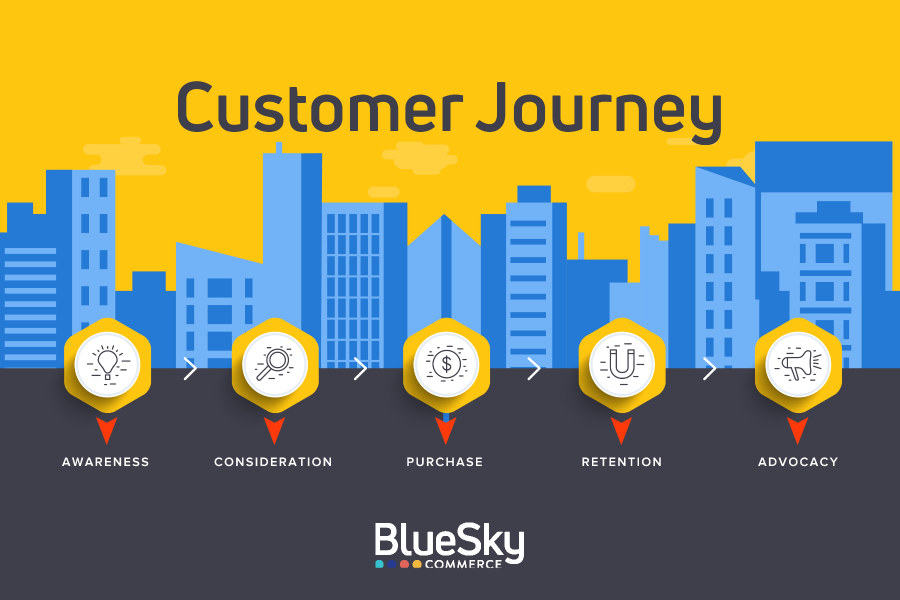Why does a buyer spend the time to load up their cart just to abandon it? Could it be you don’t have a clear path to purchase on your website, and maybe the customer just threw in the towel out of aggravation? A Customer Journey Map could be just what you need to develop a profitable relationship with your new and existing clients. We will be discussing why a customer journey map is vital to all business websites, the importance of personas, and the steps needed to successfully create a customer journey map for your specific customer needs.
Let’s start at the beginning. Every website should direct customers to your end goal, in most cases, a purchase. Whether you want to educate the consumer or complete a sale, both paths should have a way to accomplish your goals. This “path,” now referred to as a “journey,” is a visual representation of the intended flow of your website. Creating a map to guide the visitor can help your company boost its customer experience resulting in a higher conversion rate.
In most cases, a customer journey map is not a straight path to purchase. For example, your customers could go to various areas of your website, such as the contact us or customer service pages, before checking out. However, understanding the detours away from your ultimate goal is extremely important and can be a valuable resource to your sales team.
Understanding the three stages in a buyer’s journey
- Awareness Stage:
The customer is becoming aware of the problem they are facing, and they begin researching to find out how to solve the problem or pain point. - Consideration Stage:
The customer is researching and looking for ways to solve their problem, finding all possible options to compare so they have the optimal solution. Then, they weigh the pros and cons of each solution to determine their next steps in solving the problem. - Decision Stage:
The customer determines the shortlist of solution providers. They need to know that you can fulfill their needs. Your content should be about your company or product at this stage.
But, that’s not the end of the story. After you have a loyal customer, you need to nurture the relationship so that they become an advocate for your brand. What could be better than to have your brand shared with all of their friends, and then their friends?
Six steps to an effective customer journey map
1. Set targets. Why are you making this map? Determine what you want to achieve and have a clear goal in mind. The first step in creating the customer journey map is collecting data from customers and website visitors. This analysis will help you set realistic goals for your website.
2. Develop a buyer persona. A persona is a fictional customer with stated demographics and psychographics comparable to your typical customer. The best way to understand your customer is to interview existing customers, especially ones who have purchased in the past. Put yourself in their position and look at your website in an objective light. Understanding how they think and the paths they typically take to find a solution are keys to uncovering the optimal way to reach your customers and give them the best experience possible.
3. Identify pain points and motivations. What stops the customer from completing the goal or sale? Can they find what they are looking for, and is it the optimal choice to solve their problem? Making your process a positive experience will, in turn, tie your brand to a positive experience.
4. Maximize your touchpoints. Touchpoints are considered any encounter with your brand and the customer. The touchpoints could be by digital or traditional means. For example, touchpoints could be email campaigns, newsletters, paid ads or direct mail, television, or radio spots sharing your website URL. The more touchpoints you can create, the better! The type of industry is also a critical piece of information to discover when considering customer touchpoints. B2B vs. B2C business models can have a journey map wildly different from each other. B2B businesses typically have more touchpoints in their journey, requiring more engagement and relationship development to help the customer make their final decision.
5. Walk in your customers’ shoes: Determine all the stops, or touchpoints, on the journey, for your website and social channels, emails, and paid ads where the customer might communicate with your company. If you find that customers are skipping steps, take a close look and determine which touchpoints should be removed to streamline the customers’ journey.
6. Evaluate and revise as necessary. Continue to evaluate your work and adjust as necessary. Remember, this is a living journey, and you need to be flexible and ready to listen to your customers. Also, what resources do you have, and where are you lacking tools for a better customer experience? Creating a customer journey map brings to light where you are deficient. It is also valuable to grab a piece of paper or sticky notes and physically map out this journey.
The team at BlueSky Commerce understands and optimizes the steps needed to help potential customers navigate your website efficiently. As a result, you can be confident that your website does its job representing the best of your products and services. So reach out when you are ready to start a conversation!





